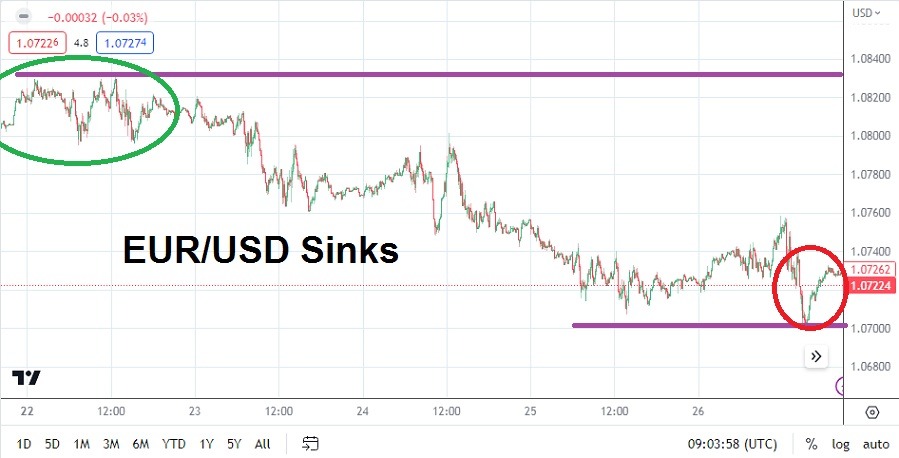Traders who have jumped onto the selling bandwagon of the EUR/USD have likely enjoyed the past handful of days. Downwards price action continued most of last week for the EUR/USD as market sentiment remained nervous. The bearish trend of the EUR/USD has been rather strong since the first week in May; the currency pair touched a high of 1.10950 on the 3rd of this month, but since then has incrementally lost value.
It needs to be noted that the selling of the EUR/USD has correlated to other major currency pairs. In other words, the EUR is not alone while losing value to the USD. While support levels have certainly been brushed to the side and the EUR/USD has been made to look vulnerable the past four weeks, the price action mirrors broad Forex market conditions. The U.S Federal Reserve continues to rattle financial institutions who had assumed the Fed was likely done raising their Federal Funds Rate. However, the past few weeks have continued to deliver signals further interest rate hikes may happen.
European Economic Data is Troubling and Has Increased Nervous Sentiment in the EUR/USD
High inflation statistics and poor growth numbers from the European Union remain problematic. Germany will release Preliminary Consumer Price Index numbers on Wednesday and the results could have an effect on the EUR/USD. However, traders must acknowledge a lot of the impetus for the EUR/USD likely continues to come from U.S economic data and Federal Reserve rhetoric. Monday will be a major banking holiday in many places in Europe and the U.S., and speculators should know volumes will be low which may cause some momentary flashes of volatility tomorrow.
USD/EUR Bearish Trend and the 1.07000 Level could be confronted via Important Risk Events
- After coming in sight of the 1.07000 level on Friday, traders should monitor this support early this week. If the 1.0700 ratio falters this could signal additional bearish sentiment could ignite.
- The U.S. debt ceiling talks should be watched; while an agreement is expected a failure to find an end to the crisis could spark additional risk-averse Forex conditions short-term.
- Non-Farm Employment Change and Hourly Average Earnings will be released from the U.S. on Friday. Inflation data continues to show signs of stubbornness, and if wage data this week is strong the U.S. Federal Reserve rhetoric may be forced to remain aggressive.
EUR/USD Weekly Outlook:
The speculative price range for EUR/USD is 1.06610 to 1.08475
Traders who have been looking for a sustained upside reversal from the EUR/USD the past few weeks have likely run into tough speculative conditions. Technically the EUR/USD is now within sight of important values last seen in late March. If the EUR/USD were to break below the 1.07000 level, traders will need to consider the potential the currency pair could actually begin to challenge the 1.6900 to 1.06700 levels.
Speculators who are still dreaming about the 1.10000 mark for the EUR/USD should put aside their ambitious targets this week and seek goals upwards that are less ambitious. Institutional money remains rather nervous as financial houses worry about U.S central bank outlook regarding the Federal Funds Rate.
The ability of the EUR/USD to give up its higher realms this past month shows again that Forex trading can prove dangerous and is affected by behavioral sentiment. There is no doubt one month ago financial institutions largely believed the U.S. Fed would not be able to stay aggressive regarding their interest rate policy.
Many traders may still believe this is the case, but the downward trend is the actual price of the EUR/USD and momentum has been downward as the realization that higher interest rates from the U.S may be delivered. Traders looking for upside momentum should be cautious and use take profit orders to take advantage of fast reversals, which may disappear rather quickly. Caution has ruled the EUR/USD the past few weeks and the coming days may see a continuation of these trading conditions.


